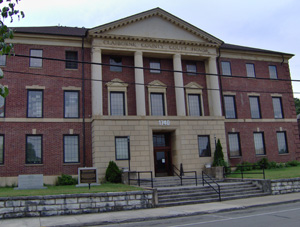
Claiborne County
The Tennessee General Assembly formed Claiborne County in 1801 from parts of Grainger and Hawkins Counties and named it for William C.C. Claiborne, Tennessee’s first congressional representative. The most important historic feature of Claiborne County is the Cumberland Gap, located south of the convergence of Tennessee, Virginia, and Kentucky. Native Americans called this natural gateway to the north and west the “Warrior’s Path.” In 1750 Dr. Thomas Walker claimed discovery of the gap and named it Cumberland Gap in honor of William Augustus, Duke of Cumberland, the son of King George II and Queen Caroline. In 1775 Daniel Boone led thirty men through the gap and opened a road west to settlement.
The first settlement occurred in the Powell Valley along the Clinch River. Shortly afterwards, settlements were established at Sycamore Creek and Fort Butler. In 1801 the town of Tazewell was laid out as the county seat of Claiborne County. The town received a post office in 1804, and James Graham served as the first postmaster. The county court met three times in the homes of John Hunt and Elisha Walling before a small frame courthouse was erected in 1804 on land belonging to John Hunt Sr., probably the first settler in the area and the first sheriff of Claiborne County. A jail was constructed at the same time as the courthouse, and a second jail was built in 1819. Luke Bower, one of the first Watauga settlers, was the first attorney in Claiborne County. The first merchant was William Graham, a native of Ireland. Graham had extensive real estate holdings, and around 1800 he completed a stone residence known as the Graham-Kivett house. Other historic buildings include the Parkey house, also thought to have been built by Graham, which was used as a hospital during the Civil War and survived the great fire of 1862. A frontier church at Springdale on Little Sycamore Creek was erected by Drew Harrell and the Reverend Tidence Lane sometime around 1796.
Tazewell did not have a church building until 1815, but settlers probably worshipped in open-air assemblies and in homes prior to that time. William Graham, a Presbyterian, erected the first church building, which was probably used by all denominations. In 1844 the Baptists and Methodists both erected buildings on Russell and Church streets respectively.
Although a few attended a school opened at Yoakum’s Station in the Powell Valley in 1820, most children of the early Tazewell settlers received no formal education until Walter Evans opened a small school in 1822. Michael Miles, the teacher at Yoakum Station, and Evans collaborated in the writing of text books. In 1835 a boys’ academy opened in Tazewell near the town spring, but the Tazewell Female Academy was not organized until 1854. In 1856 Tazewell Academy was raised to the rank of college.
Claiborne County and the Cumberland Gap figured prominently in the Civil War strategy of both the North and the South, changing hands four times. Today, traces of the old military road that connected battlements on the pinnacle above Cumberland Gap can be discerned. Battery No. 6 still remains at the Tri-State peak facing Cumberland Gap. Rifle pits dug around most batteries can be located with little difficulty. Although no major battles were fought in the county, there were several bloody skirmishes. On November 11, 1862, a fire broke out in Tazewell and destroyed some twenty buildings including the courthouse, a large hotel, and several brick storehouses.
On February 12, 1897, the State of Tennessee chartered Lincoln Memorial University, named for Abraham Lincoln, who had urged O. O. Howard of the Freedmen’s Bureau to do something for the people of the area. Howard accepted Lincoln’s charge and played an important role in the creation of the institution. The university proved a boon for tri-state area residents who could not afford college tuition but were able to work their way through LMU by working on the college farm. Today, LMU rents the farm for pasture. The 1,000-acre campus, which presently serves two thousand students, incorporates traditional architecture and modern technology. The Abraham Lincoln Museum, which holds one of the largest Lincoln collections in the country, is located on the campus.
Present-day Claiborne County consists of 277,963 acres. Its population grew from 13,373 in 1880 to 23,286 by 1920. The rapid growth was attributed to intensive mining developments and logging operations. By 1950 the population had increased to 24,788, but over the next decade, Claiborne County began to experience out-migration as people left the area for industrial employment in the Midwest. The population dropped to 19,067 in 1960 before beginning a slow rise that boomed in the 1980s and 1990s. The 2000 population was 29,862.
Claiborne County has a mixed economy with a growing industrial sector. County farmers produce tobacco and vegetables, and the largest industrial employer is Bushline, a furniture manufacturer. Other furniture manufacturers in the county include Brooks Furniture Manufacturing and Oakwood Furniture Manufacturing. Four textile manufacturers, two pre-built and mobile home manufacturers, and a large medical supply manufacturer (DeRoyal Industries) keep the county’s unemployment rate low. The 1996 opening of the Cumberland Gap Tunnel on U.S. Highway 25W, a model of transportation planning, promises to further enhance the economic outlook of the county in the twenty-first century.



